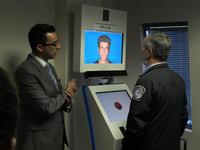-
House panel charges DHS overstates deportation figures
A House committee says the administration inflates the number of illegal aliens it has deported in 2011 and 2012; the committee says the administration is able to cite larger numbers of deportees by including numbers from the Alien Transfer Exit Program (ATEP) in the administration’s year-end removal numbers; if the number of ATEP-removed individuals is subtracted from ICE-deported individuals, then the annualized number of deportees in 2011 and 2012 would lower – rather than higher – than the number of deportees in 2008 and 2009
-
-
Border Patrol kiosk detects liars trying to enter U.S.

The U.S. Customs and Border Protection (CBP) is using border crossing stations in Arizona to test new technology to detect liars as they attempt to enter the country; travelers are subjected to a 5-minute interview with the kiosk, while microphones monitor vocal pitch frequency and quality, an infrared camera monitors eye movement and pupil dilation, and a high definition camera monitors facial expression
-
-
DHS seeks better ways to detect ultra light aircrafts used by smugglers

As the war on drugs continues with every sunrise and sunset, DHS has awarded a contract just short of $100 million for a specialized system which will be able to detect ultralight aircrafts which are used to smuggle drugs across the border
-
-
Manned planes beating drones as the more capable tool in war on drugs

In the never-ending war on drugs, U.S. Navy planes are showing that technology does not necessarily mean improvement, as manned planes are outmaneuvering unmanned drones in catching cocaine smugglers traveling by sea; in 2011 the manned planes caught an average of $30 million of cocaine per day, and during the last five years they have detected more than 853,000 pounds of cocaine
-
-
Obama’s sweeping immigration initiative goes into effect next week

On 15 August 2012 a sweeping new immigration initiative, the most significant easing of immigration policy since President Ronald Reagan granted amnesty to an estimated three million people in 1986, goes into effect; it would defer deportation action against, and grant a work permit to, illegal immigrants who meet certain criteria
-
-
Critics charge Obama initiative is amnesty by executive order
Critics of the Obama administration’s immigration order charge that the administration is”legislating by executive edict”; they say that the Obama administration is set, in effect, to begin implementing the DREAM Act amnesty on 15 August, even though the legislation was defeated by Congress as recently as December 2010
-
-
Deportation deferment executive order to cost between $467 million and $585 million
On 15 June the administration issues an executive order deferring deportation against illegal immigrants who were brought into the United States as kids by their parents, and who now go to school or have graduated from school; illegal aliens eligible to apply can begin to do so in August, and DHS estimates that in the first year of the program, about a million or so would do so; the processing cost would be as high as $585 million; each applicant will be expected to pay $465 in paperwork processing fee, but even if all do, there will be a shortfall
-
-
Critics: Obama administration advancing amnesty by executive order
A new study by an anti-illegal group provides a detailed, 3-year timeline of what the groups describes as the Obama administration’s strategy of carrying out a policy of de facto amnesty for millions of illegal aliens through executive policy decisions
-
-
Federal apprehensions for immigration violations declined, while arrests tripled, in 2000-10

Apprehensions for immigration violations peaked at 1.8 million in 2000 but dropped to 516,992 in 2010 — the lowest level since 1972, according to a report released last week by the Justice Department’s Bureau of Justice Statistics (BJS); between 2000 and 2010, arrests booked by the U.S. Marshals Service for federal immigration offenses tripled, from 25,205 to 82,438 arrests; immigration apprehensions resulted in about 16 arrests per 100 apprehensions in 2010, up from 2 arrests per 100 in 2002
-
-
ICE agents say Obama’s 15 June executive order makes their job more difficult
Association of ICE agents complains that the 15 June executive order which deferred deportation action against certain classes of illegal immigrants makes it difficult for ICE to enforce immigration laws
-
-
California passes “Anti-Arizona” immigration measure

The California State Senate last Thursday passed Assembly Bill 1081 — some call it the Anti-Arizona law — under which local police officers would be limited to refer only those individuals convicted of serious felonies to immigration agencies; police officers would no longer have authority to detain lower-level offenders on their undocumented status
-
-
Deadline for ASIS Accolades Competition approaches
ASIS International 58th Annual Seminar and Exhibits will be held in Philadelphia on 10-13 September; one of the highlights of the show is the ASIS Accolades Competition, which is open to exhibitors in the event; Deadline for Submissions is 23 July
-
-
Biometrics proves 1 percent of applicants to enter U.S. are unsuitable
Chris Archer, the online content editor at IDGA (the Institute for Defense & Government Advancement), talked with James Loudermilk, Senior Level Technologist, FBI Science and Technology Branch, about biometrics and biometrics and homeland security; Loudermilk says that biometrics applications helped the FBI determine that about 1 percent of people who seek visa to visit the United States as tourists have previously done things that make them unsuitable guests; the conversation examines the application of biometrics for homeland security, issues relating to privacy and civil liberties, and what can be learned from international biometrics projects, including India’s UID scheme
-
-
Supreme Court deals near-fatal blow to Arizona SB 1070; states’ immigration efforts now in question

In a major victory for the Obama administration, the U.S. Supreme Court yesterday struck down three of the four main provisions in Arizona’s tough SB 1070 immigration law, saying these provisions were pre-empted by federal law; the Court left in place the fourth provision – the one requiring Arizona local law enforcement during routine stops to check the immigration status of anyone they suspect is in the country illegally – but in reading the provision very narrowly, the Court left its implementation open to legal challenges on grounds that it violates racial profiling prohibition and other laws; in any event, the administration moved quickly to make that remaining provision meaningless by pulling back on a program known as 287(g), which allows the federal government to deputize local officials to make immigration-based arrests; the move means that even if local police step up immigration checks, they will have to rely on federal officials to make the arrests
-
-
Supreme Court suggests Obama’s DREAM initiative is legal
On 15 June the Obama administration announced a new deportation policy, saying that it would defer deportation action against undocumented immigrants in several categories; the administration based its decision on the doctrine of “prosecutorial discretion”; critics charged that such deferment policy is illegal; the Court, in its decision on Arizona SB 1070, suggests the administration is right, saying: “A principal feature of the removal system is the broad discretion exercised by immigration officials”
-
- All
- Regional
- Water
- Biometrics
- Borders/Immig
- Business
- Cybersecurity
- Detection
- Disasters
- Government
- Infrastructure
- International
- Public health
- Public Safety
- Communication interoperabillity
- Emergency services
- Emergency medical services
- Fire
- First response
- IEDs
- Law Enforcement
- Law Enforcement Technology
- Military technology
- Nonlethal weapons
- Nuclear weapons
- Personal protection equipment
- Police
- Notification /alert systems
- Situational awareness
- Weapons systems
- Sci-Tech
- Sector Reports
- Surveillance
- Transportation
Advertising & Marketing: advertise@newswirepubs.com
Editorial: editor@newswirepubs.com
General: info@newswirepubs.com
2010-2011 © News Wire Publications, LLC News Wire Publications, LLC
220 Old Country Road | Suite 200 | Mineola | New York | 11501
Permissions and Policies
Editorial: editor@newswirepubs.com
General: info@newswirepubs.com
2010-2011 © News Wire Publications, LLC News Wire Publications, LLC
220 Old Country Road | Suite 200 | Mineola | New York | 11501
Permissions and Policies
